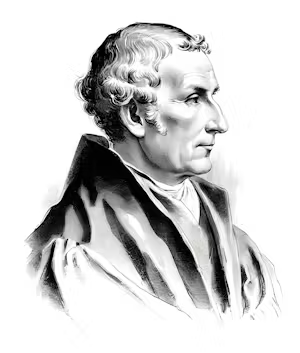Martin Bucer
1491–1551
The Protestant Melting Pot
Martin Bucer may be the most important Reformer you’ve never heard of. He led in the shadow of the other German giants Luther and Melanchthon, but he manned the helm of what became, at least for a time, the capital city of the Protestant world.
Bucer was born near Strasbourg on November 11, 1491. At fifteen, he joined the Dominican cloister, a monastic group of Roman Catholic preachers. Friars like Bucer carried out the vows of poverty, chastity, and obedience, but unlike monks, they did so among the people, serving in community, not in isolation.
Germany’s Most Eligible Friar
Martin Bucer first heard Martin Luther in April of 1518 (Bucer was 26; Luther, 34). He was captivated by Luther, especially his conviction that we are justified by faith alone apart from any contribution or merit of our own. Three years later, he not only left the Dominican order in order to preach the gospel, but he also abandoned his monastic vows and decided to marry, suddenly making him, perhaps, Germany’s most eligible (and radical) friar. He married a nun (no less) named Elizabeth.
While Luther had led Bucer into the Reformation, Bucer did not see eye to eye with his spiritual father on everything, in part because he had already been heavily influenced by Erasmus, whom he appreciated and admired despite their theological differences. Bucer’s generally more inclusive and ecumenical bent providentially positioned him to play a significant role in the wider movement.
Reformation in Moderation
Strasbourg became the hub of Protestantism in large part because Bucer and other leaders remained openhanded on many of the most controversial and divisive issues. For instance, in 1529 Bucer brokered a historic, if hostile, meeting between Luther and Zwingli over the Lord’s Supper. Being himself predictably sympathetic in both directions, he brought the two sides together hoping to achieve the kind of agreement that might catalyze the unification of the two main threads of the Reformation.
While the meeting failed to birth an accord over the Table, it illustrates the kind of role the former friar played — between Luther and Zwingli, between mainstream Protestants and the more radical Anabaptists, even between Reformers and Catholics. Instead of forming and leading a distinct movement of his own — the Bucerans, if you will — he strived to bring movements together under the clear teaching of Scripture into one great Christian melting pot. He realized and prized the precious power of solidarity.
First Small Groups
As the strange spiritual offspring of Luther and Erasmus, Bucer’s Reformation took on a distinct and eclectic flavor. Initially, he simultaneously stressed that justification is by faith alone, while also zealously demanding Spirit-empowered discipline and good works in the Christian life. Good so far. However, later in life he spoke of a kind of “double justification” that was at least confusing, if it did not in effect blur the line of “faith alone.”
One way or the other, Bucer cared about Christian conduct. As a result, he persistently pursued means of church discipline. First, he went to the officials in Strasbourg, pleading for stricter enforcement. When the government refused to impose more rigorous standards for obedience, he formed voluntary groups of believers within local churches for the purpose of regular accountability and church discipline. Thus, Bucer may very well be the unlikely (and reluctant) father of the modern small group.
After being exiled, John Calvin witnessed the kind of church discipline chartered in Strasbourg and built on the same principles when he returned to Geneva. Calvin spent some of his happiest years learning from Bucer in Strasbourg, while pastoring a congregation of fellow French refugees.
German Glue
Bucer’s first wife, of twenty years, died from the plague in 1542. On her deathbed, she encouraged Martin to marry Wibrandis Rosenblatt. Wibrandis, later nicknamed “The Bride of the Reformation,” had already married and buried three leading reforming men: Ludwig Keller, Johannes Oecolampadius, and Wolfgang Capito (also from Strasbourg). Just seven years later, she buried her fourth.
While the former friar helped pioneer the path to marriage for converted monks, he also opened a wider door for divorce, but only as “an absolute last resort and generally rare, rather like the death penalty for adultery” (Reformation, 660). His exceptions became a sharp edge carving out similar openness across Protestant Europe.
In 1549, as the Augsburg Interim forced Protestants in Strasbourg to readopt traditional Catholic beliefs and practices, Bucer accepted Thomas Cranmer’s invitation to take refuge for a time in Cambridge, England, as Regius Professor of Divinity. He died just two years later, in 1551, before he could return to Strasbourg.
Many have overlooked the lesser-known Martin, probably because he lacked the timing of Luther and Zwingli and the nuanced precision of Melanchthon and Calvin, preferring instead to bridge the gap and facilitate unity among the Reformers. And that’s precisely why we should remember him — the German glue of the Protestant Reformation.
For more on Martin Bucer:
The Reformation: A History by Diarmaid MacCulloch
Reformers in the Wings by David C. Steinmetz
Marshall Segal (@marshallsegal) serves as President & CEO of Desiring God. He’s the author of Not Yet Married: The Pursuit of Joy in Singleness & Dating. He graduated from Bethlehem College and Seminary, and serves as deacon at Cities Church. He and his wife, Faye, have three children and live in Minneapolis.


